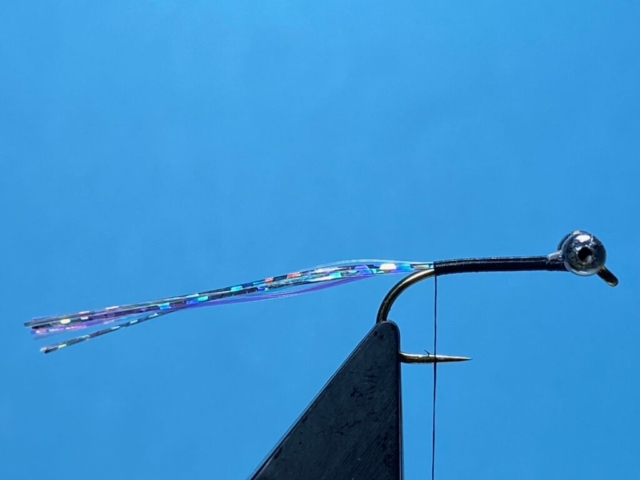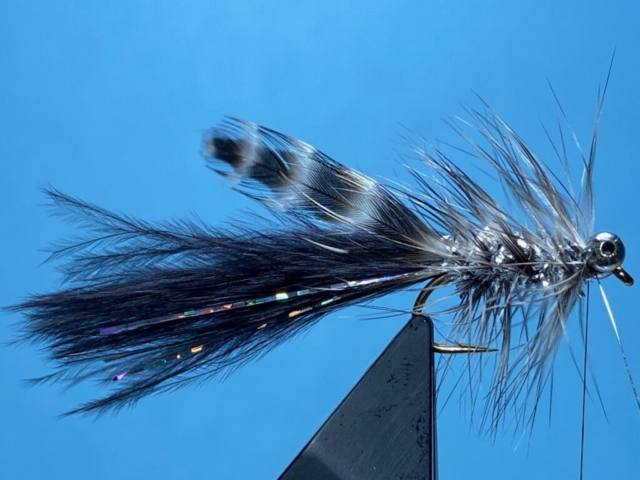
A Fly to Tie & Try in November (The Humongous) by Les Lockey
The Humongous
Hook: Kamasan B175, size 8 or 10.
Thread: Black Veevus GSP, 50D.
Eyes: Medium silver bead chain.
Tail: A dozen or so strands of silver holographic Flashabou with a bunch of black marabou over.
Rib: Silver wire, medium.
Body: 3mm. silver metallic Fritz.
Hackle: Barred Cree/Chinchilla, soft Chinese cock or grizzle hen hackle.
TYING
- Secure the hook in the vice, wind on a short bed of thread and remove the waste. Return the thread to just short of the eye.
- Secure a pair of bead chain eyes squarely on top of the shank with figure of eight thread wraps wound over a spot of superglue.
- Tie in the strands of Flashabou as a long tail and continue to bind down the strands on top of the shank, stopping just before the hook bend. Trim the Flashabou to at least twice the length of the hook.
- Take a bunch of long fibred marabou and using finger and thumb nail, strip away the fluff from the basal ends and trim them square. Tie in the marabou over the Flashabou, bind down the waste ends stopping just before the eyes and return the thread to the tail. Pinch off the ends of the marabou just longer than the Flashabou.
- Tie in a length of silver wire with a couple of well waxed turns of thread. Follow this by tying in the bared core of a length of silver metallic Fritz and bind down both the wire and the core with touching turns of thread stopping just before the eyes.
- Wind the Fritz to the eyes in close turns, stroking back the fibres after each turn. Secure the Fritz with thread at the eyes and remove the excess Fritz.
- Prepare the hackle by stripping away the fluffy fibres from the base of the stem and trim the stem to length. Now using well waxed thread, tie in the hackle by its stem behind the eyes.
- Make two turns of hackle immediately behind the eyes and continue to palmer the hackle in open turns to the tail. Trap the hackle with the wire and continue to wind the wire in open turns through the hackle to the bead eyes. Secure the wire with well waxed thread.
- Worry off the excess wire and trim away the hackle tip at the tail. Tidy the head with a few turns of thread, whip finish and remove the thread. Varnish the head to complete the fly.
Tying tips
- This is the silver version of the Humongous, but it can also be tied in gold simply by changing the colour of the flash material in the tail and body. Both colours are worth having in your fly box, together with a white tailed silver version that works well in Autumn when the trout start hitting the fry.
- Many people tie this fly on long shank nymph or lure hooks, but I’m convinced that a standard shank, strong wire, wet fly hook allows more movement in the tail making the fly more effective.
- The eyes can be tied in at the start of the dressing or at the end, whichever is easier for the tyer. I prefer to tie them in first as this sets limits for the length of the body and avoids crowding the eye when the fly is completed. A simpler option is to use a silver tungsten bead, although I have always used the bead chain eyes. I like to tie the eyes in batches and add a small dab of superglue to secure them in place.
- The original dressing calls for a soft and rather nondescript Chinese cock hackle approximating to a poor cree/chinchilla/ barred ginger combination, but to be honest, I have found them difficult to source. As a result, and since this pattern is all about movement, I have resorted to using a genetic grizzle hen hackle, which to my eyes at least, suits the silver version of this fly very well without any noticeable drop in its effectiveness . Whichever hackle is used, it should be considerably longer than normal in order to create maximum movement. This is one pattern where the fly’s action in water is far more important than its proportions as perceived by mere fly tyers.
Fishing notes
- The Humongous or “Shuggie” as it sometimes referred to, is arguably one of Scotland’s best known and most successful stillwater patterns.
- This pattern can be fished on any density line from floater to a fast sinker and at any time of year although it tends to works best early and late in the season.
- A common and very successful setup for competition fishing is to fish a silver Humongous on the point and a gold version on the top dropper with a tequila blob on the middle dropper but casting such a rig is not for the feint hearted, nor for those like me who favour a much lighter weight rod. Personally, I would fish the pattern as a single fly on either a long sink tip or an intermediate line using either a slow figure of eight retrieve, or with long exaggerated pulls and stops.












Recent Comments